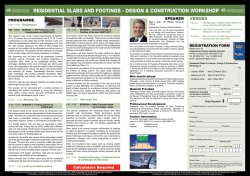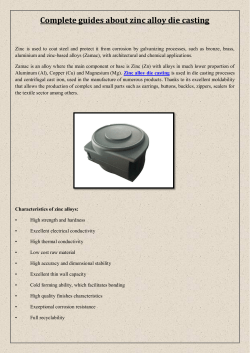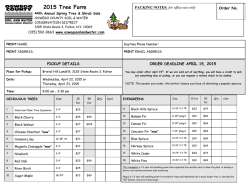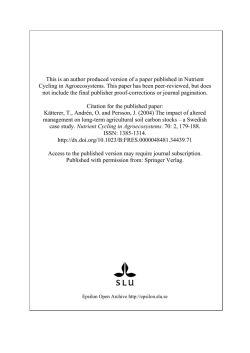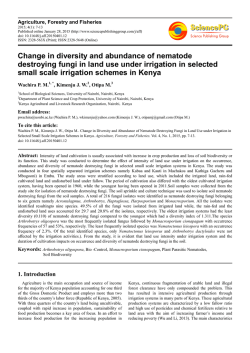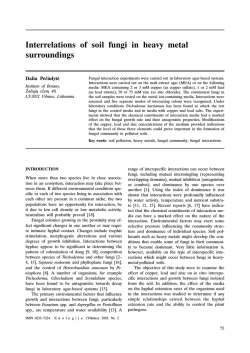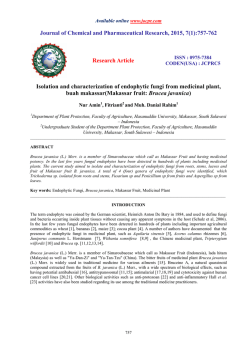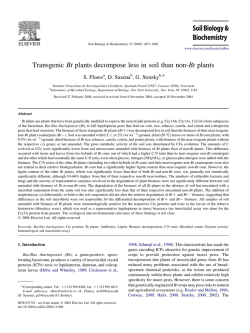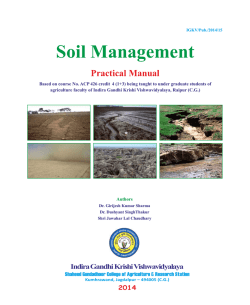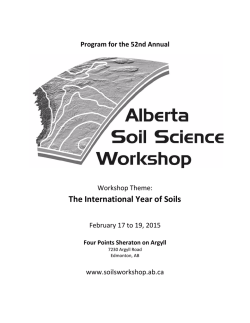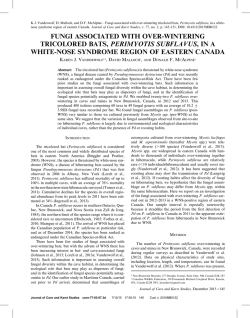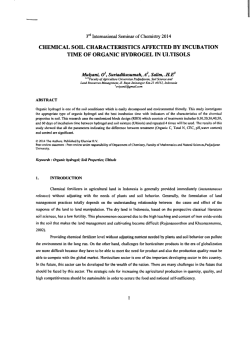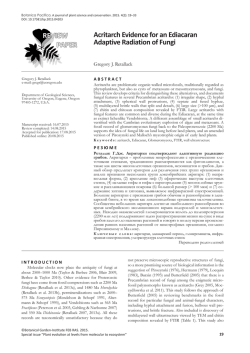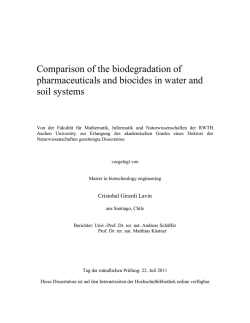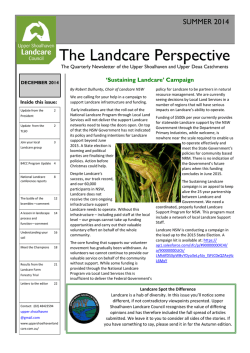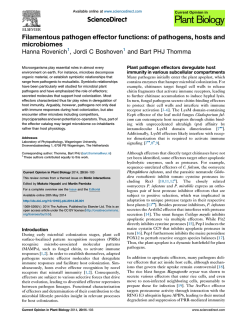
Research of the influence of zinc on soil mycoflora with special
Research of the influence of zinc on soil mycoflora with special attention to Zn-resistant fungi Research of the influence of zinc on soil mycoflora with special attention to Zn-resistant fungi D. Peèiulytë Institute of Botany, Þaliøjø eþerø 49, LT-2021 Vilnius, Lithuania A study of fungal propagules was conducted in commune garden soil amended with ZnCl2 (Zn2+ at 402 mg·kg1) and incubated at 18 °C and with moisture content approx. 60%. Fungal resistance to zinc ions was estimated by dilution plating on malt agar (MEA) containing Zn2+ at 2.6, 3.9, 5.2, 6.5 or 13.0 mg ml1 (as ZnCl2). The fungi Emmonsiella capsulata, Eurotium herbariorum, Gliocladium penicilioides, Metarrhizium anisopliae, Paecilomyces lilacinus and Talaromyces flavus were the most Zn-resistant species recovered from test soils. Key words: fungi, soil pollution, zinc ions, indicator cultures There is a number of general points that must be considered before discussing the interaction of fungal cells with individual metal ions. These include the role of metals in normal fungal growth, deficiency and toxicity effects, and the relation of chemical properties of metals to their toxicity [14]. A metal may be regarded as toxic if it impairs growth or metabolism of an organism above a certain concentration. Zinc is essential for fungal growth [1], becoming toxic only at high concentrations [5]. The toxicity of zinc at a high concentration has been reported to be due to the creation of magnesium deficiency [6] and to the competition between Zn2+ and Mg2+ for transport into cell [1, 7]. High zinc concentrations inhibit organic acid and protein production [8] and the cellulolytic activity of soil fungi [5]. Mineral fertilization increases the content of mobile forms of heavy metals in soil in Lithuania [9]. Their amounts did not reach dangerous concentrations, however, the amounts of mobile zinc detected in soil were quite high (up to 102 mg Zn2+ kg1 soil). The average Zn2+ concentration in Lithuanian soils varies from 28.4 to 58 mg kg1 soil [10]. The aim of the present work has been to estimate how zinc ions in polluted soil can change the fungal community structure and which fungi remain resistant in the medium with high zinc concentrations. ed of vegetative detritus, slowly air-dried and sieved (2 mm). To one portion (2 kg) of the soil Zn2+ was added at 402 mg kg1 soil as ZnCl2 (545 mg kg1). After mixing the soil with zinc and moisturizing it up to 60% total water capacity, samples (control without zinc addition) were incubated at 18 °C for 3 months, mixing the soil from time to time. Fungi were isolated from the soil by dilution plating on 9 cm diam. Petri dishes, using a hydrous dilution medium with 8.5 g NaCl and 1 g peptone l1. Malt extract agar (MEA) was used as nutrient media. A medium was amended with ampicillin (100 µg/ml) to inhibit bacterial growth. Mycelial growth of the genus Trichoderma was reduced by addition of 0.1% TritonX-100. The Petri dishes were incubated at 25 °C in the dark. The total number of fungi (cfu g1 soil D. W.) was enumerated after 4 and 7 days. Six samples of soil were processed. The most common species present in the soil samples were studied on zinc-containing MEA. ZnCl2 was added to MEA, the media were modified by adding 2.6, 3.9, 5.2, 6.5 or 13.0 Zn2+ mg ml1. Colonies on each Petri dish were counted, and representative fungal colonies were transferred on Sigma maltextract agar (MEA), Sigma Czapek agar (CA), Sigma potato-dextrose agar (PDA), Sigma cornmeal agar (CMA) and incubated at 25 °C for seven days. The following systematic works were used: Domsch et al., (1980) [11], Raper et al., (1968) [12] and Êèðèëåíêî (1977) [13]. MATERIALS AND METHODS RESULTS AND DISCUSSION The soil was sampled in communal garden plots. It was a sandy loam (pHKCl = 7.3). The sample was clean- The total number of fungi in test soils (Fig. 1-A) after 1, 2 and 3 months of incubation under model INTRODUCTION ISSN 13920146. B i o l o g i j a . 2001. Nr. 4 ' D. Peèiulytë a high number of genera that were frequently reco25 70 vered from Zn-containing 60 C 20 soil. Detection of these 50 Zn 15 genera and estimation of 40 their concentrations was 30 10 conducted by addition of 20 5 ZnCl2 at various concen10 trations to a malt agar 0 0 medium. On the modified MEA 2,6 3,9 5,2 6,5 13 0 1 2 3 Tim e (m onths ) Zinc c onc entration (m g/m l M E A ) MEA, fungi of the genera Cylindrocladium MorFig. 1. Fungal concentration (103 cfu/g soil d.w.): A in the control (C) and zinc-congan, Emmonsiella Kwontaining soils at the beginning of study and after 1, 2 and 3 months of incubation; B on Chung, Eurotium Link ex malt agar (MEA) and MEA-containing different Zn2+concentrations Fr., Metarrhizium Sorok. and Paecilomyces Bain. conditions and fungal population density on media were abundantly isolated from the Zn-containing soil with different zinc concentrations (Fig. 1-B) were (Fig. 3A). The concentration gradient of Zn2+ in detected. The number of fungi in control soil at the MEA allowed us to detect Zn-resistant fungi. Mebeginning of study was estimated to 4213 cfu g1 tarrhizium anisopliae (Metschn.) Sorok.was most resoil. Lower concentrations of fungi in control soil sistant to ZnCl2 in test soil and on the dishes with were detected after 1, 2 and 3 months of incubation Zn-containing MEA. M. anisopliae grew on the me(2521, 1986 and 2247 cfu g1 soil, respectively). The dium with Zn2+ at a concentration of 13 mg ml1 fungal concentration recovered from zinc-containing and comprised 82.8% of the total number of Znsoil was higher than from control soil. The viability resistant fungi (Fig. 3B). During investigation of the of fungi in zinc-containing soil increased after one fungal communities in test soils, M. anisopliae was months, but after 3 months it was almost the same one of the most slowly growing fungi on standard as in control soil (2989 cfu g1 soil). The difference MEA. In mixed cultures on MEA medium M. anibetween the total cfu numbers in two soils after 1 sopliae was a weak antagonist, as it was a weak and 2 months of incubation was statistically signifi- antagonist also in non-sterile soil [11]. The reduccant. In an earlier study A. Raguotis (1999) [5] exa- tion in growth appeared to be related to a strongly mined the effect of ZnSO4·5H2O on the growth and aggressive action of mycoparasites dominating in the activity of microorganisms in forest soil and repor- fungal associations. ted a very weak stimulation effect of small zinc conZn-resistant species of fungi were isolated on centrations on fungi. The toxicity of zinc sulfate ap- MEA medium. Zinc chloride was added to MEA at peared only at a concentration greater than 700 mg a concentration of 2.6, 3.9, 5.2, 6.5 or 13.0 Zn2+ mg kg1 soil (or 243.32 mg kg-1 Zn2+). Some fungal ml1. A modified medium allowed us to isolate fungenera isolated from Zn-containing soil in our study gi of the genera Metarrhizium and Cylindrocarpon lost their antagonistic activity on standard malt agar and to detect the concentration of viable fungi of media. Their population density decreased or they the genera Eurotium, Gliocladium and Paecilomyces grew very slowly. in Zn-containing soil (Fig. 3). On these media were Samples of test soil were analyzed for total numbers of different taxonomic groups of fungi. Others The major isolated fungal genera Verticillium were Aspergillus Mich. Ex Fr., CyTrichoderma lindrocarpon Wollenw., GlioclaPenicillium dium Corda, Fusarium Link ex Fr., Mucor+Mortierella Mortierella Coemans, Mucor Mich. Gliocladium Zinc-containing soil Fusarium Ex St.-Am., Paecilomyces Bain., PeControl soil Aspergillus nicillium Link ex Fr. and Trichoderma Pers. Ex Fr. (Fig. 2). 0 10 20 30 40 50 Stimulation of some fungi in Percentage Zn-containing soil was noticed according to a difference of genera in test soil fungal communities. Fig. 2. Percentage of fungal genera isolated from control soil and soil with Zn2+ Results presented in Fig. 2 show at 402 mg kg1 during 3 months of incubation at 18 °C * c fu (thousands )/g soil c fu (thousands ) / g soil ) Research of the influence of zinc on soil mycoflora with special attention to Zn-resistant fungi Others 10 0% Pen+A s p+ Talaromy c es P. lilac inus 80 % 60 % 40 % 20 % 0% ) Zn - 200 m g/ m l 2,6 3,9 5,2 6,5 13 Zinc con centratio n (m g /m l) Metarrhiz ium anis opliae Eurotium herbariorum Emmons iella c aps ulata Cy lindroc ladium s c oparium * Fig. 3. Percentage of Zn-resistant fungal species on media with different (A) and with 6.5 mg/ml (B) Zn2+ concentrations detected, isolated and studied the Zn-resistant species Metarrhizium anisopliae, Zygorrhynchus moelleri and Cylindrocladium scoparium. Zinc at a concentration of 13 mg ml1 was fungistatic to the most fungi of the test soil fungal community. M. anisopliae and Eurotium herbariorum (Wiggers) Link ex Gray were two fungi recovered on that medium. On a medium with Zn2+ at a concentration of 6.5 mg ml1 fungi Paecilomyces lilacinum (Thom) Samson, Cylindrocladium scoparium Morgan, Emmonsiella capsulata Kwon.-Chung and some species of the genera Aspergillus and Penicillium were also abundant and were strong antagonists towards cellulolytic fungi (Trichoderma, Fusarium and Chaetomium Kunze ex Fr.). A negative influence on the growth of cellulolytic fungi was noticed. Population density of the genera Trichoderma, Fusarium, Mucor and Mortierella decreased in zinc-containing soil (Fig. 2A). However, after 3 months of study the Trichoderma population density in Zn-containing soil increased and almost reached the control level. A decrease of cellulolytic activity in soil samples was detected in forest soil [5]. According to the most research reffered to in Domsch et al., (1988) [11], zinc is essential for Aspergillus niger, Emmonsiella capsulatum, Zygorrhynchus moelleri and some species of the genera Paecilomyces and Penicillium. The influence of zinc on the production of antibiotics which contribute to the ecological competence of pseudomonads further indicates that this trace mineral is a key environmental signal in biocontrol [14]. References 1. Ross IS. Trans Br Mycol Soc 1975; 64 (2): 17593. 2. Gingell SM, Campbell R, Martin MN. Environ Pollut 1976; 11 (1): 2537. 3. Jordan MJ, Lechevalier J. Can J Microbiol, 1975; 21: 185565. 4. Gadd GM. New Phytologist 1993; 124: 2560. 5. Raguotis A. Ekologija 1999; 3: 7883. 6. Adiga PR, Sivarama Sastry K, Venkatasubramanyan V, Sarma PS. Biochem J 1961; 81: 54550. 7. Abelson PH, Aldous E. J Bacteriol 1950; 60: 40113. 8. Áåêêåð ÇÝ. Ôèçèîëîãèÿ è áèîõèìèÿ ãðèáîâ. Ì.: Èçä-âî Ìîñê. óí-òà, 1988. 9. Rimðelis J. Sunkiøjø metalø kiekis ir aktyvumas ávairiai sukultûrintame velëniniame jauriniame priesmëlio dirvoþemyje, Daktaro disertacija. Dotnuva-Akademija, 1996. 10. Maþvila J, Adomaitis T, Eitmanavièius L, Lubytë J, Matusevièius K, Antanaitis A. Sunkieji metalai Lietuvos dirvoþemiuose ir augaluose. Dotnuva, 1999: 356. 11. Domsch KH, Gams W, Anderson T-H. Compendium of Soil Fungi. London: Academic Press, 1980. 12. Raper KB, Thom C, Fennell DJ. A Manual of the Penicillia. The Williams and Wilkins Company, Baltimore, 1968. 13. Êèðèëåíêî ÒÑ. Àòëàñ ïî÷âåííûõ ãðèáîâ. Êèåâ: Íàóêîâà äóìêà, 1977. 14. Duffy BK. Phytopathology 1997; 87: S26. D. Peèiulytë CINKO POVEIKIO DIRVOEMIO MIKROFLORAI TYRIMAI AKCENTUOJANT CINKUI ATSPARIUS MIKROMICETUS Santrauka Mikromicetø pradø kiekio tyrimai atlikti kolektyvinio sodo dirvoþemyje, praturtintame cinko chloridu (402 mg kg1 Zn2+), sudrëkintame iki 60% drëgnumo ir laikytame 18 °C temperatûroje. Mikromicetø atsparumas cinkui (cinko chlorido forma) buvo ávertintas suspensijos skiedimo ir auginimo ant skirtingas cinko koncentracijas (2,6, 3,9, 5,2, 6,5 ir 13,0 mg ml1 Zn2+) turinèios alaus misos terpës. Mikromicetai Emmonsiella capsulatas, Eurotium herbariorum, Gliocladium penicilioides, Metarrhizium anisopliae, Paecilomyces lilacinus ir Talaromyces flavus ávertinti kaip cinkui atsparûs tirtame dirvoþemyje.
© Copyright 2025
